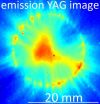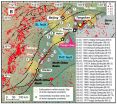(Press-News.org) WASHINGTON D.C., November 18, 2014 - On a quest to design an alternative to the two complex approaches currently used to produce electrons within microwave electron guns, a team of researchers from Euclid TechLabs and Argonne National Laboratory's Center for Nanoscale Materials have demonstrated a plug-and-play solution capable of operating in this high-electric-field environment with a high-quality electron beam.
Unfamiliar with microwave electron guns? Perhaps best known within the realm of X-ray sources, microwave electron guns provide a higher current and much higher quality electron beams than conventional DC guns. Beams of this sort are also used in free-electron lasers, synchrotrons, linear colliders and wakefield accelerator schemes.
But the electron emission mechanisms involved -- laser irradiation of materials (photocathodes) and heating of materials (thermionic cathodes) -- tend to be complex, bulky or extremely expensive.
To simplify the process, as the team describes in Applied Physics Letters, they turned to a third electron emission mechanism -- field emission -- to create a plug-and-play solution based on ultrananocrystalline diamond (UNCD) originally introduced at Argonne.
Field emission "is a process of liberating electrons from solid-state materials into a vacuum by the electric field," said Sergey Baryshev, a material scientist, and Sergey Antipov, an accelerator physicist, working for Euclid TechLabs. "A strong electric field on the surface induces tunneling propagation through the surface barrier. So, essentially, our field-emission cathode (FEC) is an electron source alternative to photo or thermionic cathodes, which use an intense laser or high temperatures to liberate electrons," added Antipov.
At Argonne's Center for Nanoscale Materials, field emission properties of UNCD have been studied for several years, and researchers were able to demonstrate that UNCD performs better even in planar configurations, unlike other diamond films, which need to be shaped into high aspect ratio structures to locally enhance electric field and produce significant currents. "This is due to the unique carbon bonding configuration within the few-atoms-wide grain boundaries surrounded by nano-sized UNCD grains, which yield very high field enhancement naturally," noted Ani Sumant, a nanoscientist and UNCD specialist at Argonne.
The team's study is the first known actual testing of a planar thin UNCD film in an electron injector, in which UNCD film virtually replaces a part of an inner copper wall subject to the strong oscillating electric field. One surprise was discovering that "UNCD provides such a large charge and peak current with such low angle divergence and energy spread of the electron beam -- both of which are comparable with photocathodes," Baryshev said. "The produced electron beam is of very high quality."
Importantly, UNCD survived under harsh conditions in the microwave gun without noticeable degradation for an extended period of time. "The planar geometry of UNCD may help distribute the total electric field experienced by narrow grain boundaries--more than a trillion per square centimeter," explained Sumant.
While the UNCD FEC may one day become a true commodity electron source for conventional copper-based accelerators, the team expects to see the most interesting implications within the field of superconducting radio frequency (SRF) accelerators.
"SRF systems potentially offer higher duty cycles, which equate to higher production rates, which is important for industry," said Chunguang Jing, vice president of Euclid TechLabs. "Until now, though, SRF systems weren't considered attractive by industry because their wall-plug efficiency is low and, compared to conventional systems, mainly caused by using warm electron injectors with photocathodes (lasers) or thermionic (heaters) cathodes."
An accelerator is a complex system, and on a very basic level it's analogous to the microwave oven or kettle in your kitchen, so you can determine its wall-plug efficiency -- essentially how much consumed electricity was actually used vs. wasted.
"For SRF and conventional copper systems to produce an electron beam, this parameter is 10 percent. Its consumed energy will be 10 times greater, because 90 percent of it is wasted," noted Baryshev. "It was previously demonstrated that if SRF were fully cryogenic under liquid helium temperatures, wall-plug efficiency could be boosted to 50 to 60 percent. Our UNCD FEC may enable this option by avoiding any warm parts within an SRF system."
Why is all of this so significant? One compelling reason is that fully cryogenic high-efficiency SRF accelerators can quickly translate into huge electricity cost savings -- on the order of millions of dollars per year -- compared to electron accelerator facilities using conventional accelerators.
The team's technology is relevant to "many existing industrial and medical challenges -- including those of the highest national importance," Baryshev added.
INFORMATION:
The article, "Planar ultrananocrystalline diamond field emitter in accelerator RF electron injector: Performance metrics" by Sergey V. Baryshev, Sergey Antipov, Jiahang Shao, Chunguang Jing, Kenneth J. Pérez Quintero, Jiaqi Qiu, Wanming Liu, Wei Gai, Alexei D. Kanareykin and Anirudha V. Sumant appears in the journal Applied Physics Letters on Nobember 18, 2014. (DOI: 10.1063/1.4901723). See: http://scitation.aip.org/content/aip/journal/apl/105/20/10.1063/1.4901723
ABOUT THE JOURNAL
Applied Physics Letters features concise, rapid reports on significant new findings in applied physics. The journal covers new experimental and theoretical research on applications of physics phenomena related to all branches of science, engineering, and modern technology. See: http://apl.aip.org
Medications, such as chemotherapy, are often limited by their tendency to be detrimental to healthy cells as an unintended side effect. Now research in the November 18th issue of Cell Press's Biophysical Journal offers a new computational model that can help investigators design ways to direct drugs to their specific targets.
A major problem with many cancer drugs is the harmful effects they can have on normal cells. Similarly, treatments for a variety of other diseases can have side effects by acting on cells that are not meant to be targeted. Researchers have tried ...
A mother's "TLC" not only can help soothe pain in infants, but it may also impact early brain development by altering gene activity in a part of the brain involved in emotions, according to new study from NYU Langone Medical Center.
By carefully analyzing what genes were active in infant rat brains when the mother was present or not present, the NYU researchers found that several hundred genes were more, or less, active in rat infants experiencing pain than in those that were not. With their mothers present, however, fewer than 100 genes were similarly expressed.
According ...
(BOSTON) - A major challenge faced by the pharmaceutical industry has been how to rationally design and select protein molecules to create effective biologic drug therapies while reducing unintended side effects - a challenge that has largely been addressed through costly guess-and-check experiments. Researchers at the Wyss Institute for Biologically Inspired Engineering at Harvard University offer a new approach, in a study published today in Biophysical Journal.
"I believe that biology is the technology of this century," said the study's senior author and Wyss Institute ...
STANFORD, CA Today, scientists at the Natural Capital Project share new science and open source software that can calculate risk to coastal and marine ecosystems. These novel tools, described in the journal Environmental Research Letters, were used to design the first integrated coastal zone management plan for the Caribbean country of Belize.
Conducted with the Coastal Zone Management Authority and Institute in Belize and the World Wildlife Fund, the study offers a comprehensive explanation of the process used to calculate risk of habitat degradation in marine spatial ...
CAMBRIDGE, MA -- MIT chemists have developed new nanoparticles that can simultaneously perform magnetic resonance imaging (MRI) and fluorescent imaging in living animals. Such particles could help scientists to track specific molecules produced in the body, monitor a tumor's environment, or determine whether drugs have successfully reached their targets.
In a paper appearing this week in Nature Communications, the researchers demonstrate the use of the particles, which carry distinct sensors for fluorescence and MRI, to track vitamin C in mice. Wherever there is a high ...
CORVALLIS, Ore. - The bacteria that helped cause the near-ruin of two large oyster hatcheries in the Pacific Northwest have been mistakenly identified for years, researchers say in a recent report.
In addition, the study shows that the bacteria now believed to have participated in that problem are even more widespread and deadly than the previous suspect.
Although the hatchery industry has largely recovered, primarily by better control of ocean water acidity that was also part of the problem, the bacterial pathogens remain a significant concern for wild oysters along ...
Findings play important role in understanding impact of oral health on heart
35 extra cases of serious heart infection every month in the UK
Prescription of antibiotic prophylaxis has fallen by 89 per cent
Scientists at the University of Sheffield have identified a significant rise in the number of people diagnosed with a serious heart infection alongside a large fall in the prescribing of antibiotic prophylaxis to dental patients.
The pioneering study is the largest and most comprehensive to be conducted with regards to the National Institute for Health and Care ...
NEW YORK, NY - November 17, 2014 - A new study has identified an FDA approved cancer drug, crizotinib, as a possible new coating for drug-eluting stents. Researchers found that crizotinib in mice helped prevent the narrowing of blood vessels after stenting without affecting the blood vessel lining. Results of this study were published today in the Journal of Clinical Investigation.
To find a more effective drug to use on stents, researchers used a computational biology or "big data" approach to better understand the genetic pathways of re-narrowing that occurs in stented ...
November 18, 2014 -- A study just released by Columbia University's Mailman School of Public Health found that children who were exposed to antibiotics in the second or third trimester of pregnancy had a higher risk of childhood obesity at age 7. The research also showed that for mothers who delivered their babies by a Caesarean section, whether elective or non-elective, there was a higher risk for obesity in their offspring. Study findings are published online in the International Journal of Obesity.
Although previous studies have shown that antibiotics administered early ...
Boulder, Colo., USA - With a population of 11 million and located about 100 km from Beijing (22 million people) and Tangshan (7 million people), Tianjin lies on top of the Tangshan-Hejian-Cixian fault that has been the site of 15 devastating earthquakes in the past 1,000 years. An example of the disastrous events is the 1976 magnitude 7.6 Tangshan Earthquake, which killed a quarter million people.
To assess future seismic hazards along the fault, scientists from the University of California at Los Angeles (UCLA) and the Chinese Earthquake Administration (CEA) have reconstructed, ...



